If you buy through our links, we may earn an affiliate commission. This supports our mission to get more people active and outside.Learn about Outside Online's affiliate link policy
The Best Women’s Ski Boots of 2026, Tested
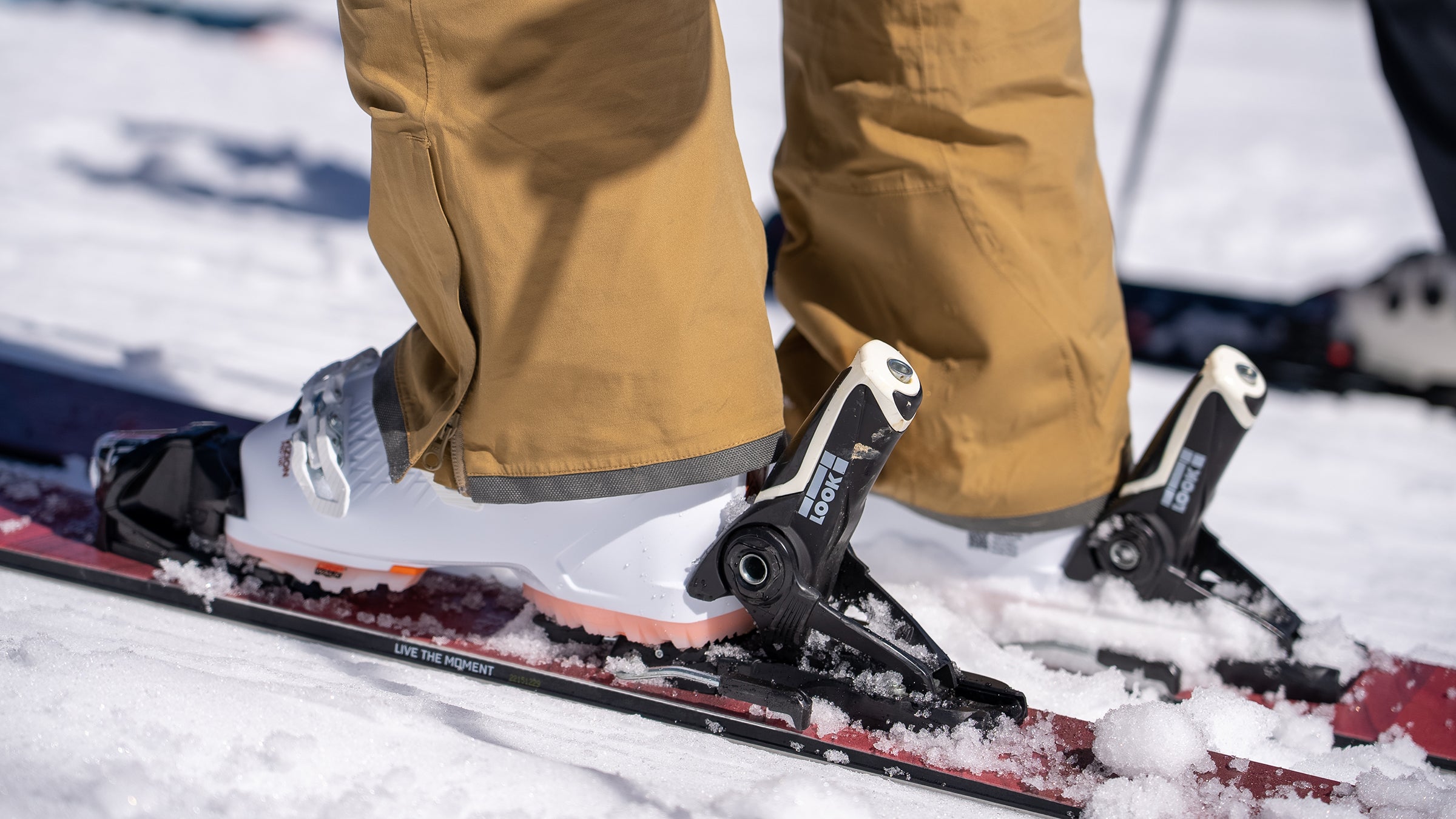
(Photo: Buster Tronolone)
Table of Contents
Shopping for women’s ski boots can feel overwhelming, but a few quick questions can help narrow your search. First, decide where you’ll spend most of your time: on resort slopes or in the backcountry. If you’re sticking to groomers and lift laps, you’re looking for traditional alpine ski boots—and you’ve come to the right place.
Next, think about fit. Most women’s ski boots come in three width categories: narrow (LV or low-volume), medium (MV), and wide (HV or high-volume). Our picks cover all three, so you can find the right shape for your foot. Not sure which you need? Try on a few pairs at a shop to get a sense of your fit “neighborhood.”
From there, it’s all about comfort and performance. With new innovations like BOA closures and hands-free-entry designs, it’s easier than ever to find a women’s ski boot that delivers the perfect mix of support and ease. And even if your boots don’t fit perfectly out of the box, most can be heat-molded or customized for a truly dialed-in feel.
Here are our expert picks for the best women’s alpine ski boots of 2026.
Best Women’s Ski Boots: At a Glance
Best in Test: Lange Shadow LV W ($750)
Best LV All-Mountain Boot: Rossignol Pure Elite GW ($850)
Best Comfort/Performance Balance: Nordica Speedmachine 3 W BOA DD ($950)
Best for Carvers: Lange RS SC ($850)
Best for Wide Feet: Salomon S/Pro Delta BOA W ($730)
Best for Intermediates: Fischer Ranger HV ($530)
The Reviews: The Best Women’s Ski Boots of 2026
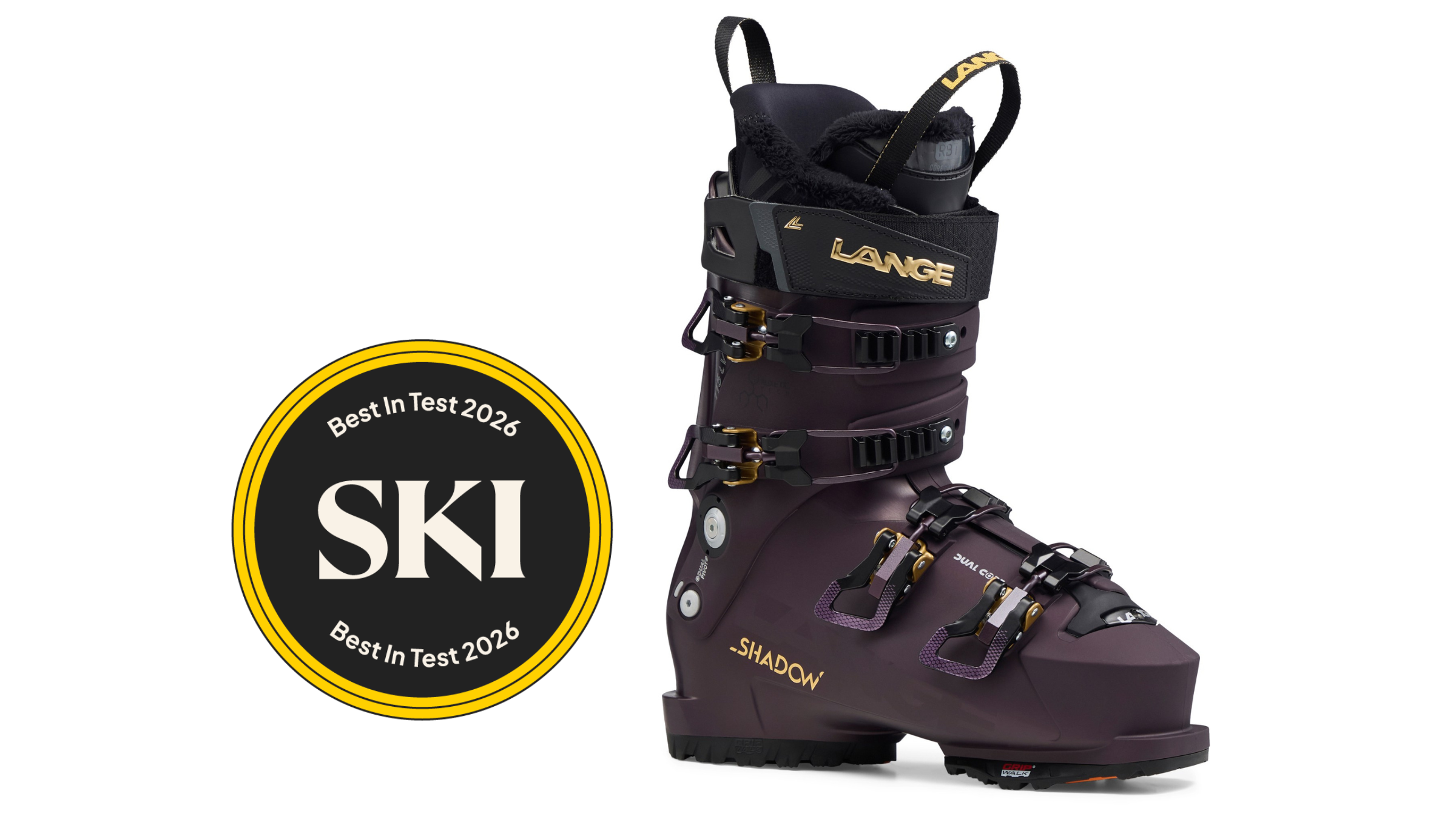
Best in Test
Lange Shadow 115 MV W
Sizes available: 22.5-27.5
Last: 100 mm
Tested Flex: 115 (also available in 95, 85)
Pros and Cons
+ Consistent medium-width fit throughout
+ Cuff offers supportive fore-aft stance
+ Seamless energy transfer to skis
– Very thick calves may require more top buckle range
If there were a competition to decide whether fit or performance deserved the headline for the Lange Shadow 115 MV W, the two would have to share it equally.
One tester called it the top performer for a perfectly balanced medium-width fit—consistent from toe to heel and top to bottom. Testers found virtually no flaws in how the boot’s curves matched the shape of the foot. They also praised the cuff height, which provided strong fore-aft support without climbing too high on the calf, though our testers with thicker legs said it was snug on them.
Lange’s stretchy, shape-adaptable and cozy Auxetic liner was another standout feature. It flexes to accommodate wider or bonier areas without pressure points, leading multiple testers to describe the fit as “hotspot-free.” While some noted the length ran slightly short, it wasn’t enough to size up—especially given the boot’s perfect fit score (10/10).
The Shadow’s winning flex feel comes from its performance-focused design. The Reactive Boost Tongue, built with a gas-bubble-filled interior, cushions the shin and delivers a smooth yet powerful push against the cuff. Testers loved the blend of plush comfort and direct ski response—soft where it should be, firm where it counts.
The Shadow’s do-more-with-less-effort boast is legitimate, said testers, who gave it two more perfect scores for its balanced stance and quickness. Several testers even claimed they skied better in the Shadow than in their own boots and planned to make the switch. High praise, indeed.
Best LV All-Mountain Boot
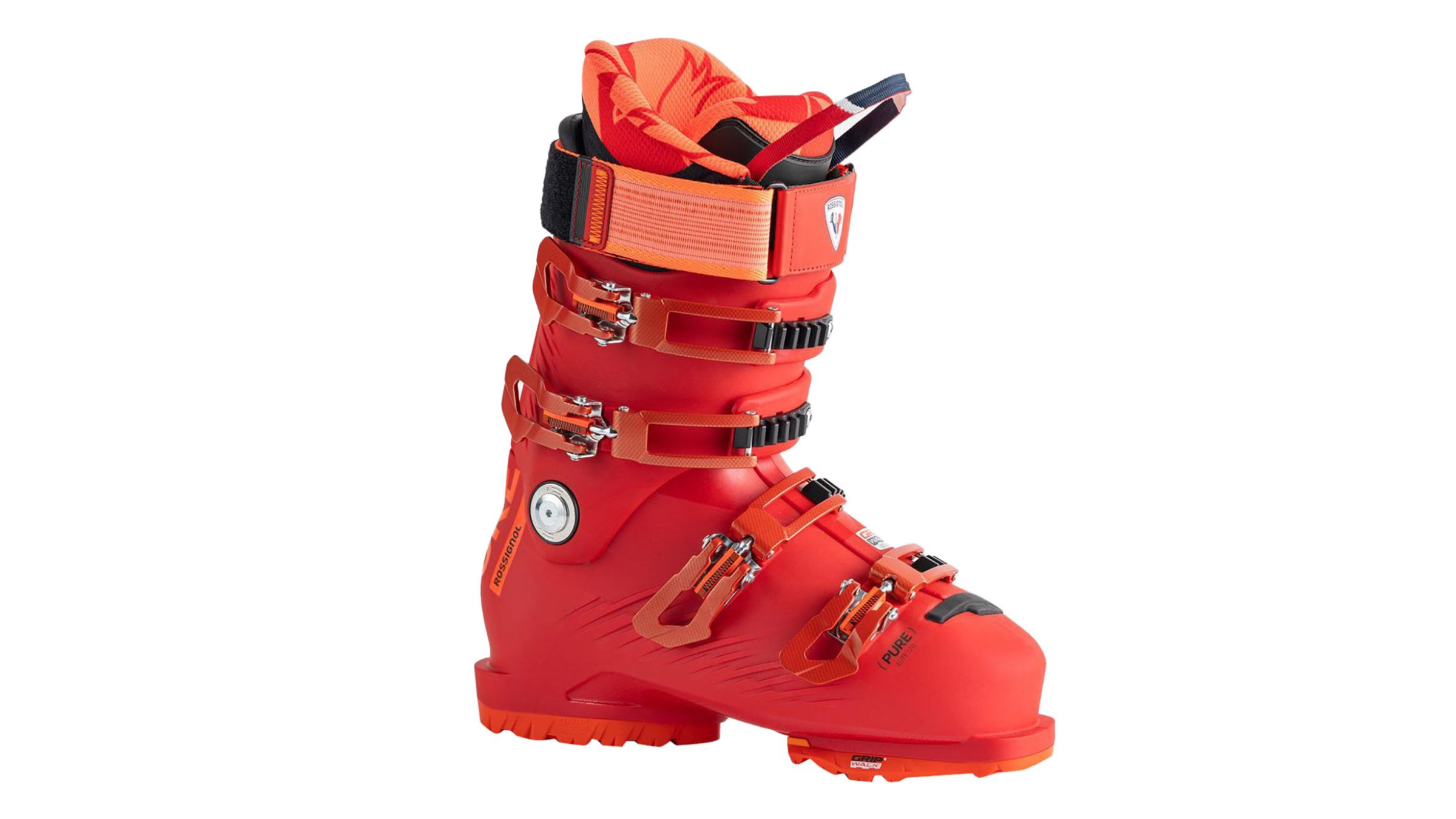
Rossignol Pure Elite 120 GW
Sizes available: 22.5-27.5
Last: 98 mm
Tested Flex: 120 (also available in 90)
Pros and Cons
+ Easy on for a 120-flex boot
+ Suits a wide variety of narrower feet and legs
+ Strong skiing on any terrain and snow conditions
– Heel pocket might not be snug enough for some
The Rossignol Pure Elite 120 returns this season unchanged. That didn’t stop it from winning the narrow all-mountain category again, and we’re not surprised. The Pure Elite 120 delivers plush comfort and confident performance across any terrain and at any speed.
For a 120-flex boot, it’s impressively easy to slide into. Once buckled, the silky entry feel gives way to a firm, secure hold on both foot and leg, without unwanted looseness. Testers agreed it hits the sweet spot for fit tension in the narrow class—snug but not constrictive. A few wished for a tighter heel pocket, but that’s an easy tweak for a bootfitter.
On snow, it earned perfect scores for stance, balance, and edge power. While it responds best to an assertive pilot, it’s forgiving enough to work for a variety of abilities—from aggressive intermediates to seasoned experts. Testers called it one of the most balanced and versatile boots of the test. It rewards precision and confidence but never punishes hesitation, making it the perfect all-day, all-mountain option for almost any advanced skier.
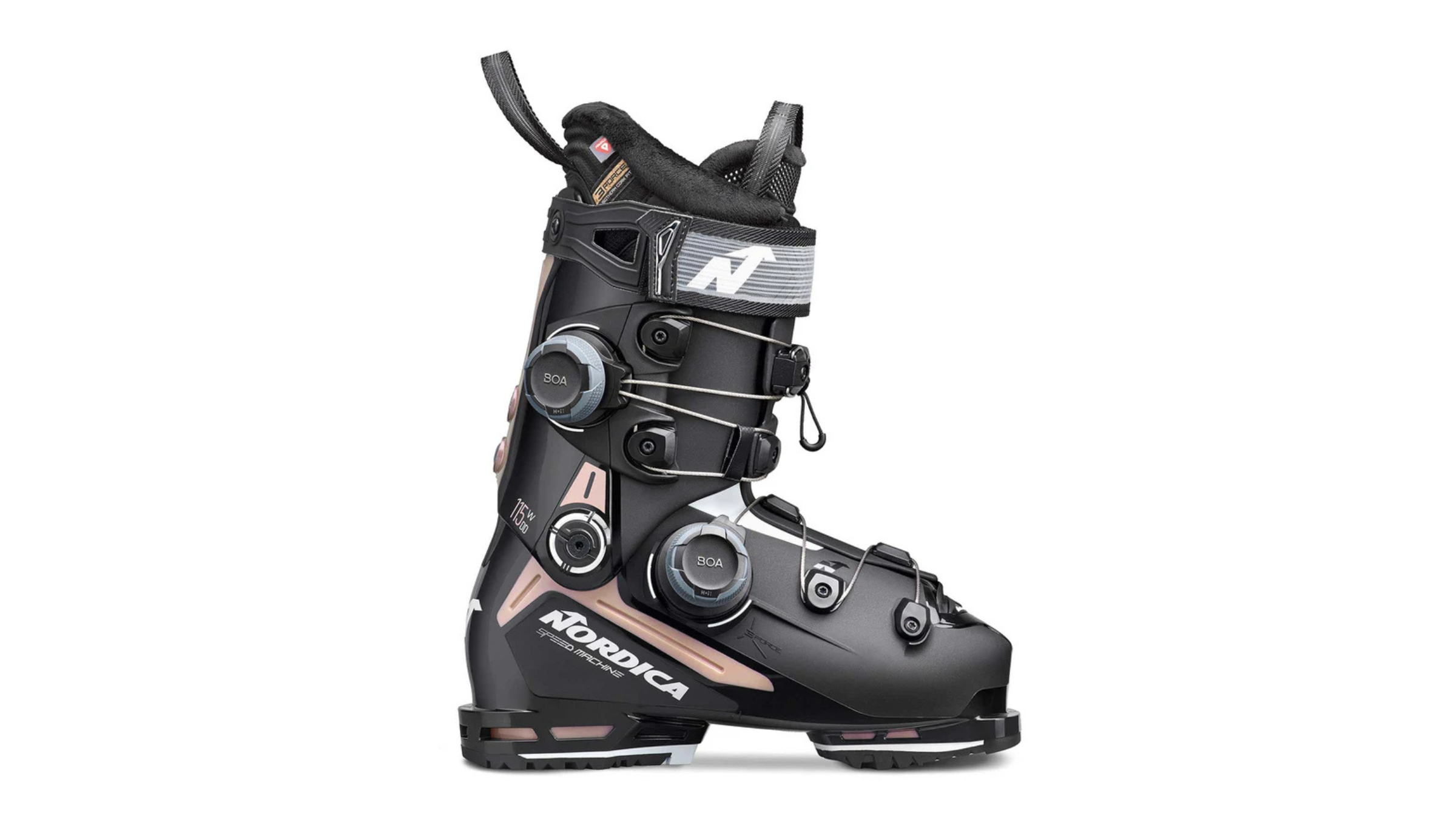
Best Comfort/Performance Balance
Nordica Speedmachine 3 115 W BOA DD
Sizes available: 22.5-27.5
Last: 100 mm
Tested Flex: 115 (also available in 105)
Pros and Cons
+ Soft, supportive liner
+ Ideal stance and cuff height
+ High-performance blend of quickness and power
– If you like traditional buckles, this is not the boot for you
The women’s Nordica Speedmachine 3 115 W BOA DD is an all-new model this year, featuring Nordica’s new “Dual Dial” design with BOA closures on both the lower shell and upper cuff.
Some testers were initially skeptical about the two BOA dials, worrying it might complicate entry. But after testing, they unanimously agreed Nordica nailed the execution, from how easily it goes on to how seamlessly it skis.
The signature Nordica liner feel—soft, silky, and supportive—remains untouched in the Speedmachine 3 115 W BOA DD, as does the perfect blend of cushion and performance we’ve come to expect from the Speedmachine range. Testers loved that the cork-reinforced liner around the ankle and heel continues to deliver both comfort and precision. One tester noted that the cuff BOA sits slightly farther back than on other dual-dial boots, which helped the liner wrap smoothly around the leg for a secure, pressure-free grip on the shin. That design detail contributed to the boot’s standout performance on snow. Testers praised its nearly perfect edge power and its sensitive, direct feel underfoot that made the ski respond instantly to every movement.
Overall, testers were impressed by this boot’s balance of comfort and control. The two-dial system made fine-tuning tension effortless: testers could tighten up or back off a click at a time, or fully release tension on the lift. The verdict: the Speedmachine 3 115 W is a powerful, responsive boot that doesn’t sacrifice comfort to get there.
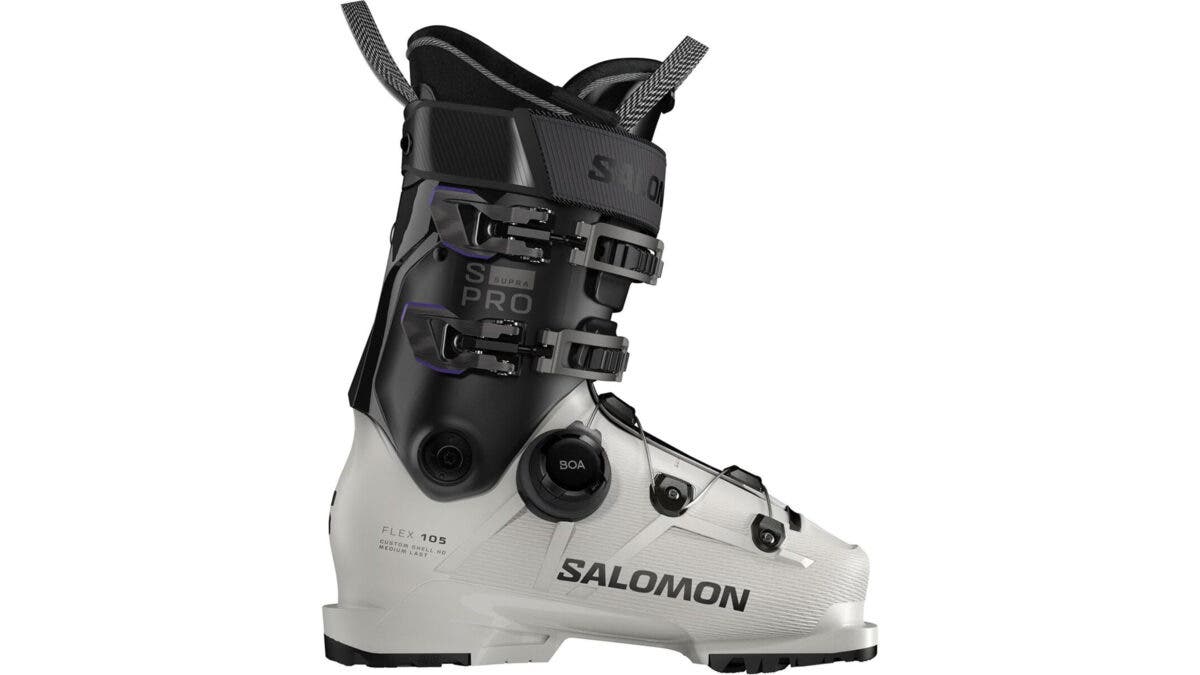
Paid Advertisement by Backcountry
Salomon S/Pro Supra BOA 105 GW Boot
Ideal for intermediate to advanced skiers tackling any terrain, the Salomon S/Pro Supra BOA 105 GW Boot is built for comfort and power. The BOA Fit System ensures a micro-adjustable, secure fit, while the 102-millimeter last and women’s-specific design gives you all-day comfort. Fine tune your flex and control with the Custom Shell HD and Power Screw, and enjoy easier walking in the lot with GripWalk outsoles.

Best for Carvers
Lange RS 120 SC
Sizes available: 21.5-28.5
Last: 97 mm
Tested Flex: 120 (also available in 110, 90, 70)
Pros and Cons
+ Immediate edge response and power
+ Offers precise control
+ Tight without fit issues
– Smooth, slippery soles
The Lange RS 120 Short Cuff (SC) has been on our list of the best ski boots for the past decade. What makes it such a consistent favorite? Simply put, testers say it delivers the best turns of any boot, especially on sharp carving skis, firm snow, and at high speeds.
Our test team includes a wide range of accomplished skiers: former racers, coaches, instructors, and all-mountain experts. They know when a boot is off in fit, stance, or power transfer. With the Lange RS 120 SC, they say everything feels right. The fit, stance, and responsiveness are all dialed, allowing them to ski at their best.
While this is a performance-focused boot, testers noted that it’s not punishingly tight. It’s snug and secure without race-boot discomfort, and last year’s tweaks improved the fit over the top of the foot—great news for anyone tired of tingly toes.
Is it for casual cruisers? No. It’s tight and stiff and unforgiving of poorly executed moves–even its hard plastic sole requires a sure-footed stride around the resort. The RS 120 SC is for skilled skiers who demand precision and power, and who know that if something’s off in their skiing, it won’t be the boot’s fault.
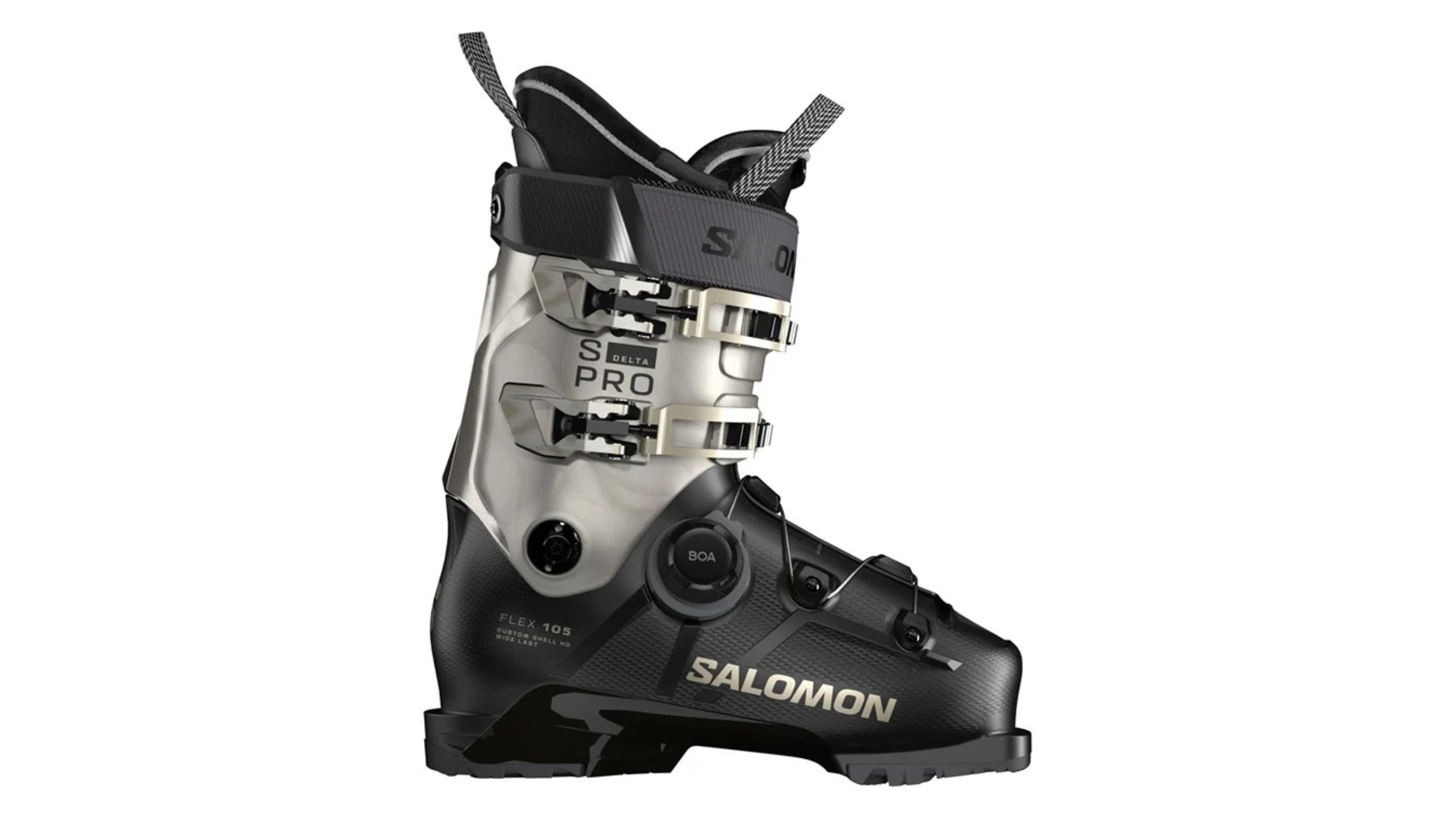
Best for Wide Feet
Salomon S/Pro Delta BOA 105 W
Sizes available: 22.0-27.5
Last: 102 mm
Tested Flex: 105 (also available in 95)
Pros and Cons
+ Fits well for a variety of foot and leg shapes
+ Skis as well as Salomon’s medium and narrow S/Pro boots
+ Offers BOA convenience without any entry hindrance
– Won’t fit truly wide feet without some bootfitting
Testers were downright smitten with Salomon’s new wide-fit S/Pro Delta BOA 105 W. One tester summed up her experience like this: “I just put my foot into a bucket of butter! Amazing liner! Great wide forefoot, but my heel is still locked in! I love this fit! I love this boot!” The enthusiasm was universal—testers couldn’t stop talking about how comfortable and secure this boot felt, and how easily it went on.
Wide-lasted ski boots haven’t always inspired such passion, but that’s changed. Today’s best wide boots combine anatomical shaping with well-tuned liners that balance openness and support. Testers said the S/Pro Delta BOA nails that formula, offering a roomy forefoot that doesn’t compromise hold or precision. They also praised its neutral, athletic stance: The Delta BOA put them in an ideal position to drive their skis with confidence and stability, regardless of foot or leg shape. Testers mentioned that for extremely high-volume feet the boot’s oven-baked Custom Shell feature can create even more room.
Performance-wise, the Delta BOA proved as balanced as its fit. Testers gave it matching 9.5 scores (out of 10) for quickness and edge power, calling it a smooth, capable performer that excelled across all terrain—from chopped-up crud to untracked powder. They noted that it felt just as composed on groomers as it did off-piste.
Perhaps most impressive is its broad versatility: forgiving enough for relaxed cruising yet powerful and stable for skiers who like to push their limits. In short, the S/Pro Delta BOA 105 W delivered everything testers want in a wide boot—comfort, confidence, and serious all-mountain performance.
Best for Intermediates

Fischer Ranger HV 95
Sizes available: 22.5-26.5
Last: 102 mm
Flex: 95
Pros and Cons
+ Skis more strongly than expected for a 95-flex
+ Offers lots of room for a big calf, wide foot, and thick instep
+ Convenient walk-mode
– Extra cushioning and room makes for less efficient power transfer to ski
One tester called the Fischer Ranger HV 95 “a good skiing boot-pillow,” and she wasn’t alone in her praise. Nearly every tester described its cushioned comfort in some way—words like “clouds” and “feathers” came up more than once. Another tester dubbed it the “silver bullet” for skiers with wider feet and higher-volume calves who want a performance-ready boot at a fair price.
The Ranger HV 95 is a classic case of under-promising and over-delivering. Testers said its flex feels stronger than advertised, making it just as suitable for advanced skiers as it is for performance-minded intermediates.
It’s a great choice for less aggressive skiers who value easy entry, warmth, and comfort, but testers emphasized that it still delivers impressive control and stability across a wide range of snow conditions and terrain. Testers did say that the ample cushioning created a minor delay in edge response, but its convenience and comfort outweighed that demerit.
Testers praised the generous fit through the toebox, forefoot, instep, and calf, noting that even high-volume legs found comfort without compromise. One tester with particularly large calves appreciated the cuff’s adjustable buckle catches, which made getting the boot closed quick and effortless.
The Ranger’s low-profile walk-mode lever also drew attention. Many testers said they nearly missed it at first because it’s tucked neatly beside the top cuff buckle. They found it easy to use and convenient for short hikes or après strolls—though, as they noted, its range of motion is modest. For most skiers, that’s just fine: after a full day skiing all over the mountain, this boot’s comfort and performance make it the perfect companion for both charging and relaxing.
Best Women’s Ski Boots Comparison
| Ski Boot | Lange Shadow 115 MV W | Rossignol Pure Elite 120 | Nordica Speedmachine 3 115 W BOA DD | Lange RS 120 SC | Salomon S/Pro Delta BOA 105 W | Fischer Ranger HV 95 |
| Price | $800 | $850 | $950 | $850 | $730 | $530 |
| Last | 100 mm | 98 mm | 100 mm | 97 mm | 102 mm | 102 mm |
| Available Flexes | 115, 95, 85 | 120, 90 | 115, 105 | 120, 110, 90, 70 | 105, 95 | 95 |
| Who It’s For | Everyone and anyone | Advanced all-mountain skiers with narrow feet | Advanced all-mountain skiers looking for performance and comfort | Advanced skiers who care about performance over comfort | For skiers with wide feet and/or large calves | Less aggressive skiers who care about comfort above all else |
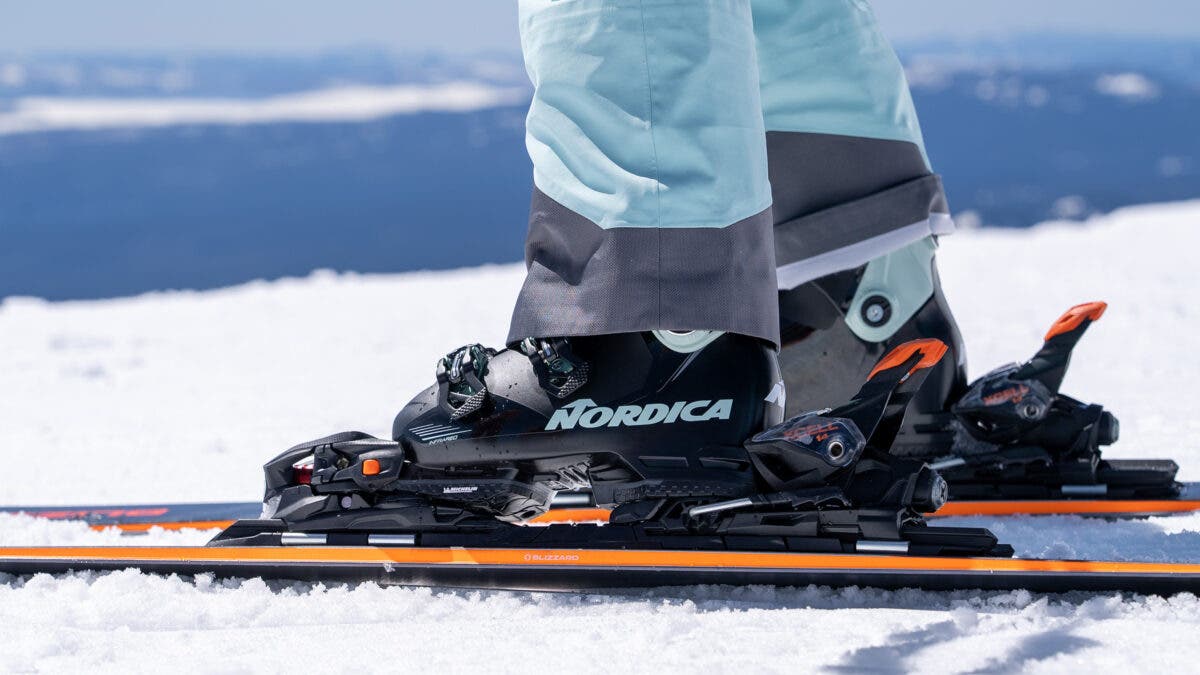
Ski Boots Buying Guide
The women’s ski boots on this list were vetted and tested by expert skiers who considered the technology, performance, fit, features, and customization characteristics of each boot. While we consider the women’s ski boots on this list to be the best of our test, which one of them might work best for you depends on your personal fit and performance needs. The best way to narrow down your choices is with a professional bootfitter’s help. That said, here are some boot search basics to get you started.
How Do I Know My Ski Boot Size?
Ski boots use mondopoint sizing, which corresponds to the length of your foot in centimeters. If you don’t already know your size, plan to get measured at a ski shop.
Most skiers are comfortable in the size they measure while seated, though some prefer the next smaller size for a snugger, performance-oriented fit. Every skier’s tolerance for feeling their longest toe at the end of the boot is different, so it’s important to talk with your bootfitter about how to achieve the right length fit without sizing up too much. Learn more here.
What Is Ski Boot Flex?
The flex index is a number that indicates how soft or firm a boot feels when you flex forward. The higher the number, the stiffer the boot. Flex ratings range widely—from about 70 for a soft women’s boot up to 140 for the stiffest non-race men’s models.
In short, you’re looking for that Goldilocks flex: not too soft, not too stiff—just right. Every skier’s sweet spot is different, but in general, lighter, shorter, or less-aggressive skiers tend to prefer softer boots, while taller, heavier, or more-aggressive skiers lean toward stiffer ones.
When trying on boots, remember that all boots feel softer at room temperature than they will on the mountain. So if a boot feels too stiff indoors—it will be. Learn more here.
What Is Ski Boot Last and Volume?
A ski boot’s last number (in millimeters) indicates the internal width of the boot at the forefoot, measured on a size 26/26.5 shell.
While that number reflects a ski boot’s width, it’s also tied to the boot’s overall volume—how much total space there is inside. Volume includes the height over the instep (top of the foot) and the room in the cuff around the lower leg. In general, narrow boots also have a lower instep and tighter cuff, while wider boots have a higher instep and roomier cuff.
Here’s a simple breakdown of how last width and volume are categorized:
- Narrow (Low Volume / LV): 96–98 mm
- Medium (Medium Volume / MV): 99–101 mm
- Wide (High Volume / HV): 102 mm and up
Everyone’s tolerance for a snug fit is different. Some skiers with wider feet are comfortable in a medium-width boot, while others with narrower feet may feel cold or cramped in a low-volume fit. If you’re unsure, try on multiple widths at a ski shop to find what feels best for you. Learn more here.
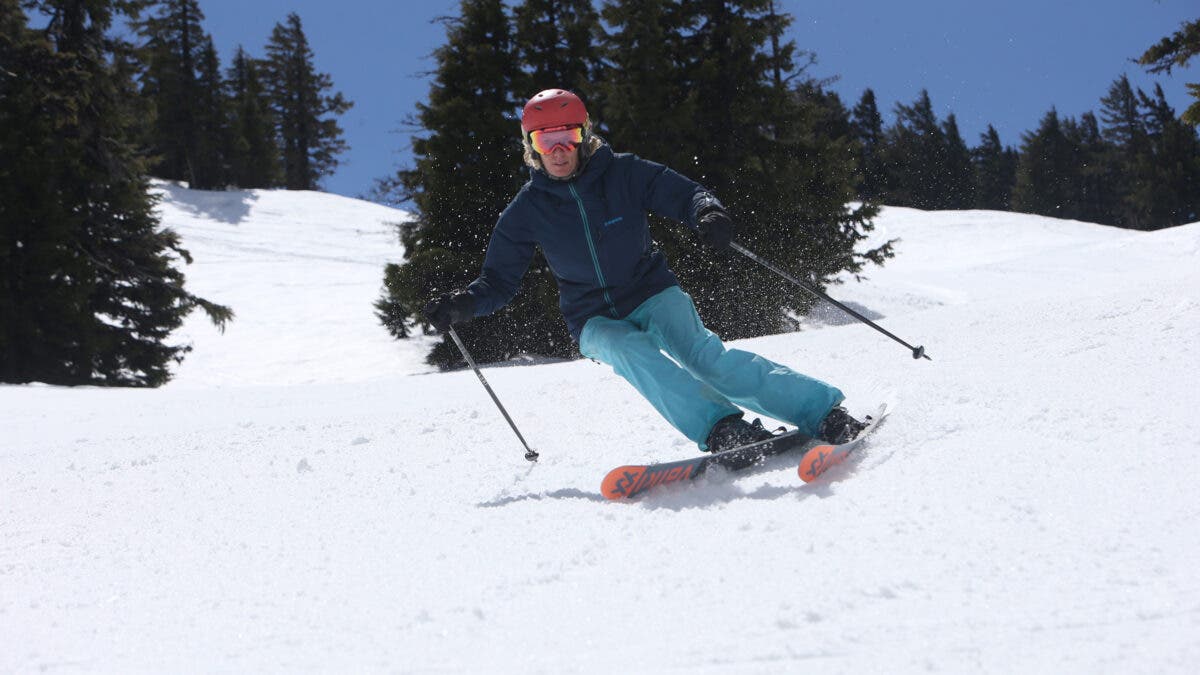
How We Test Ski Boots
Number of boots tested: 80
Number of testers: 20
Testing location: Mt. Bachelor
Vert skied in each boot: 6,000 feet
Conducting a ski boot test isn’t easy. Feet and leg shapes vary widely, and a boot that fits one tester like a Cinderella slipper can feel like a pair of vice grips to another. That’s why we partner with Masterfit/America’s Best Bootfitters, a team of professional bootfitters and expert skiers, to conduct our annual ski boot test and report back their findings.
Their boot test is among the most thorough in the industry. Every brand, large or small, is invited to submit models. This year, we tested 80 boots over an intensive eight-day period. Twenty expert testers, evenly split between men and women, averaged three runs per boot across a variety of conditions. To ensure fair comparisons, boots are evaluated within both their performance category and specific width group (LV, MV, and HV). Every year, we test boots in the following categories:
- Frontside Boots: Built for skiing firmer, smoother surfaces
- All-mountain Boots: Designed to tackle more versatile terrain
- All-Mountain Access Boots: Boots with features intended to make skiing easier and more enjoyable
Each boot is rated on 15 detailed fit and stance parameters, then scored across six key performance criteria: initial fit, on-snow fit, stance, edge power, quickness, and features. Testers are trained to work through personal fit issues and judge each boot on how it performs for its intended user.
To capture feedback in real time, testers use a proprietary smartphone app developed in partnership with Masterfit/America’s Best Bootfitters. Each boot is first evaluated straight out of the box for fit, flex, cosmetics, and entry. Then testers hit the slopes, assessing dynamic balance, edge control, quickness, steering, warmth, and overall convenience.
This rigorous, multi-layered approach allows us to provide skiers with trustworthy, nuanced guidance and identify boots that truly deliver precision, comfort, and performance on snow.
Meet the Ski Boot Experts
Mark Elling
Age: 55 | Height: 5’11” | Weight: 170
Mark Elling has worked full-time in the ski industry for over 35 years as a level 3 PSIA certified instructor, a snowcat skiing guide, and as a professional bootfitter. He runs a small bootfitting lab in Bend, Oregon, and also works on-mountain, selling and fitting boots at Mt. Bachelor Sports Pro Shop. Elling coordinates Masterfit’s annual boot test and writes the reviews that appear here and on the America’s Best Bootfitters website. He is formerly a board-certified pedorthist and is the author of The All-Mountain Skier: The Way to Expert Skiing.
Steve Cohen
Age: 70| Height: 6’3” | Weight: 225
Executive Editor of SKI Magazine from 1981 to 1994, Cohen, along with Jeff Rich, co-founded SKI’s on-hill boot test program in 1987. Cohen has been testing ski boots every year since. He and Rich founded the boot fit specialty company Masterfit Enterprises in 1994. The company teaches bootfitting at its Masterfit University, operates an organization of top bootfitting shops called America’s Best Bootfitters, and manufacturers aftermarket insoles for snow, cycle and other sport uses. These days, Cohen mostly skis steep groomers and not-too-deep powder. He adopted the Lange Shadow 130 MV last year as his daily driver boot—the first Lange that’s ever fit his foot.
More from the 2026 Winter Gear Guide
The Best All-Mountain Skis
The Best Women’s All-Mountain Skis
The Best Ski Gloves and Mittens


